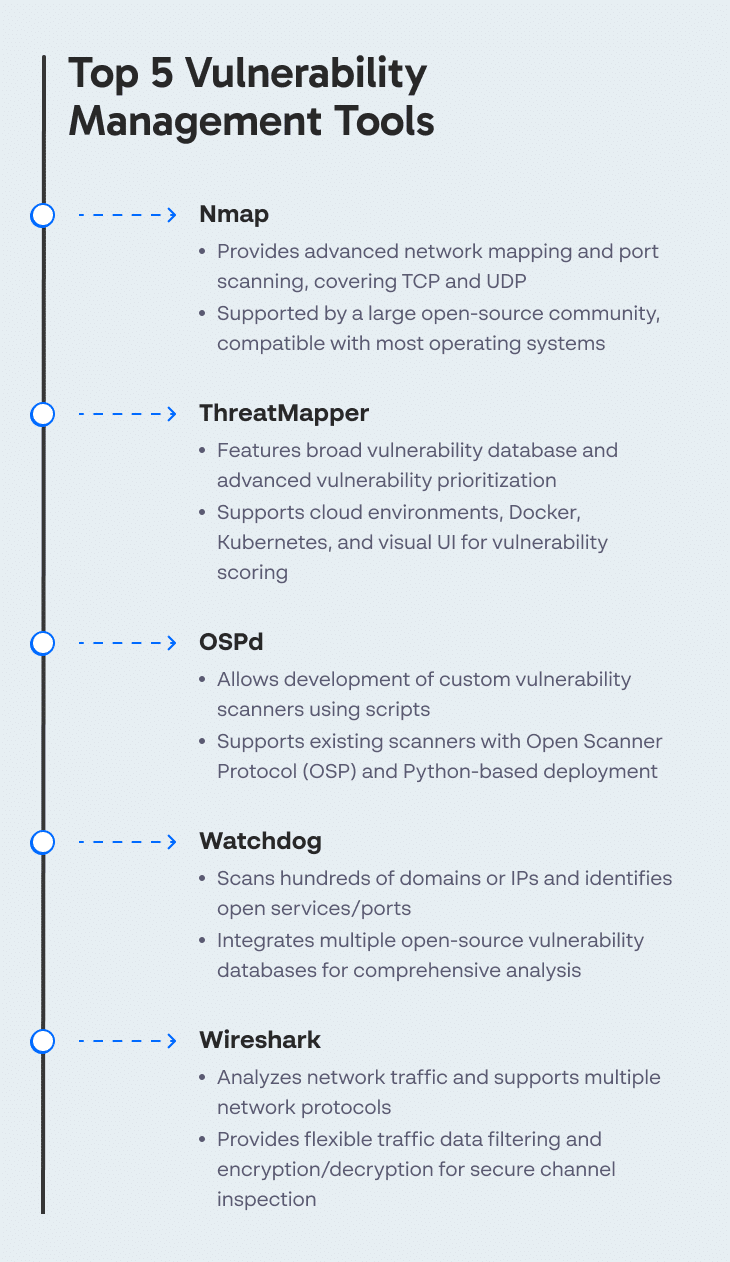Top 5 Vulnerability Management Tools
Vulnerability management tools are designed to scan networks, computing systems, and software programs for exploitable weaknesses. Upon detection of weaknesses, the tool either suggests or initiates remediation actions. The goal is to reduce the potential for a successful cyberattack.
Vulnerability management tools approach security differently than firewalls, anti-malware software, intrusion detection systems (IDS), and antivirus tools—these tools are built to manage attacks on the network as they occur. Vulnerability management tools, on the other hand, look for potential issues and fix them as needed to mitigate potential attacks.
Vulnerability management tools assess the network using IP scanners, network and port scanners, and more. Next, these tools prioritize issues to ensure that the most critical weaknesses are fixed first, and suggest practical remediation steps.
How Do Vulnerability Management Tools Work?
There are three common deployment models of vulnerability management tools:
- On-premise software programs
- Physical appliances
- Cloud-based services
Whatever the deployment model, most of these tools provide a web-based console that can configure the product to scan a range of IP addresses, web applications, or specific URLs. The broader the scan, the longer it will take to complete.
Because vulnerability scanners have complex configuration, they typically come with preconfigured scan modes, which you can use as is or modified to your needs. You can also schedule automated scans on a regular basis.
Vulnerability management tools typically perform two types of scans:
- Authenticated scans—access systems on the network without logging in, identifying issues like open ports, unsecure services, operating system and hardware versions.
- Authenticated scans—these require inputting credentials to the vulnerability scanner, and are more resource intensive, possibly affecting performance on scanned systems. These scans can provide more information about vulnerabilities, including those that affect logged in users.
It is important to realize that vulnerability scanners are the most effective when run on a regular basis:
- The first scan should cover as many resources on the network as possible and should be as deep as possible. This establishes an initial baseline of vulnerabilities.
- The following scans can be less comprehensive, and can help show trends in different parts of the network or different types of vulnerabilities.
- After a remediation effort, it is important to rescan the resources to verify that vulnerabilities are really resolved.
- Like antivirus scans, the data gained by vulnerability scans is only useful when it is up to date. Most organizations should run at least a daily scan of vulnerabilities.
Another important function of vulnerability management tools is that they enable active exploitation. Many of these tools let you not only identify vulnerabilities, but actually try to exploit it like a hacker would, in a safe manner and without disrupting operations. This can provide much more information about the extent of the vulnerability and its business impact.
Features of Vulnerability Management Tools
Here are common features you should look for in modern vulnerability management solutions.
- Dynamic discovery and inventory—ability to discover hosts and IT assets in traditional networks, cloud networks, containerized and serverless environments, and alert when new assets are created in the environment. Solutions should be able to identify device types, firmware, operating systems, ports, running services, and certificates.
- Vulnerability scanning—ability to scan any type of endpoint, including managed, unmanaged (bring your own device), cloud-based, internet of things (IoT), cloud-based resources, and containers. Advanced solutions can scan common business applications for vulnerabilities and configuration weaknesses.
- Identify risky assets—ability to scan the network perimeter, virtual machines, cloud environments, and containerized applications for vulnerable access and entry points. These could include web servers, unsecured hosts, and network devices.
- Identifying unpatched systems—ability to identify which systems on the network do not have all the necessary security updates applied.
- Prioritizing vulnerabilities—ability to map out the network, indicate where vulnerabilities are discovered, their CVE status, the severity and business impact of each vulnerability in each asset, and provide remediation instructions.
- Support for specific attack vectors—protection against important threat vectors such as phishing, ransomware, zero day attacks, supply chain attacks, and fileless attacks.
- Real-time monitoring and analysis—continuous monitoring and alerting when new vulnerabilities are discovered in any attack surface.
- Artificial intelligence and machine learning (AI/ML)—analyzing data to detect anomalous configuration changes and system behavior that may not match a known vulnerability, but may expose the system to threats. AI/ML is also used to analyze threat intelligence sources and use them to discover additional vulnerabilities.
- Remediation support—at a minimum, providing actionable guidelines for remediating vulnerabilities. Advanced solutions can support auto-remediation by applying a patch, isolating a vulnerable system, or integrating with other security systems such as firewalls and patch management.
Top 5 Vulnerability Management Tools
Nmap
Nmap is an open-source vulnerability scanner, which can rapidly scan entire networks, and identify routing configurations, firewall rules, port and services configuration. Nmap is a bit difficult to use—its primary interface is a command line and it has no visual UI. A major advantage of Nmap is that it lets you run custom scripts to scan for specific issues in your environment.
Main features include:
- Advanced network mapping—handles IP filters, firewall rules, routers, and other network equipment.
- TCP and UDP port scanning—scans all ports on the network to identify security issues.
- Large community—supported by a sizable open source community with an active Facebook page and Twitter channel.
- Covers most platforms—works with almost all operating systems including Linux, Windows, macOS, FreeBSD, Solaris, IRIX, and HP-UX.
ThreatMapper
ThreatMapper is another open-source vulnerability management tool that identifies vulnerabilities and bugs in running hosts, virtual machines, containers, container images, and repositories. It supports cloud environments, Docker, and Kubernetes. ThreatMapper provides advanced vulnerability prioritization, letting you filter vulnerabilities by risk of exploitation, attack technique, attack surface, and other criteria.
Main features include:
- Broad vulnerability database—uses data from multiple CVE and CVSS repositories.
- Visual UI— provides a graphical console that lets you view machines, VMs, and containers, perform on-demand scans, and view vulnerability scoring.
- Custom-built sensors—provides probes that can collect vulnerability data from Kubernetes, virtual machines, bare metal machines, and cloud services like Amazon Fargate.
OSPd
OSPd is a command-line-based system that lets you develop your own vulnerability scanners using scripts. It is highly customizable and uses the Open Scanner Protocol (OSP). Deployment requires Python 3.4 or higher and multiple dependencies.
Main features include:
- Leveraging existing scanners—download scanner wrappers from open-source repositories.
- Writing new scanners—lets you write new scanner wrappers and deploy them to your environment.
Watchdog
Watchdog is not a single solution, but a combination of several open source security tools. You provide a list of domains or IPs, and the solution can identify open services and ports for all the endpoints it can find. It then maps this information to a CVE database to identify vulnerabilities.
Main features include:
- Performs fast network scans for hundred of domains, IP addresses, or IP ranges
- Leverages multiple open source web application vulnerability scanners: Nmap, Google Skipfish, Wapiti, BuiltWith, Phantalyzer, and Wappalyzer
- Analyzes the technology stack analysis or each target system to see if it has known CVEs
- Leverages multiple vulnerability databases including NVD CVE, CWE, CAPEC, D2SEC, and MITRE Reference Key/Maps
Wireshark
Wireshark lets you analyze network traffic, capturing packet data and allowing you to visualize it in a graphical interface. It is very useful in examining and resolving security issues related to attackers probing the network from outside, or already inside the network.
Main features include:
- Supports multiple network protocols including Ethernet, ATM, and token ring.
- Lets you filter and analyze traffic data flexibly, and supports import and export.
- Provides powerful command-line switches that let you define what network data you want to capture.
- Built in encryption/decryption for inspection of secure channels.
- Support for common compliance reports.
- Performs ongoing monitoring of networks and servers and sends notifications.
- Enables developers to automatically add modelines to files.
Tips From Expert
In my experience, here are tips that can help you better leverage vulnerability management tools for proactive security:
- Leverage threat intelligence feeds for real-time updates Enhance your tool with external threat intelligence feeds. This keeps your vulnerability database updated with the latest known exploits, improving your ability to detect new vulnerabilities as soon as they are discovered.
- Apply contextual risk-based prioritization Use vulnerability management tools with context-aware prioritization features. These tools analyze business impact, exposure, and risk, helping you focus on vulnerabilities that pose the greatest threat to critical operations.
- Pair vulnerability management with continuous configuration auditing Vulnerabilities often stem from misconfigurations. Use tools that continuously audit configurations against best practices or compliance standards to detect potential misconfigurations alongside known vulnerabilities.
- Correlate vulnerability data with asset criticality Map vulnerabilities to asset criticality within the organization. Prioritize remediation based on the business value of the affected systems, ensuring that high-value systems are secured first.
- Deploy agent-based scanning for complex environments In cloud-native or hybrid environments, agent-based scanning is essential for deeper visibility. It can detect vulnerabilities in ephemeral workloads like containers or serverless environments, which are difficult to assess with traditional network scanners.
Vulnerability Management with Cynet
Cynet 360 is the world’s first Autonomous Breach Protection platform that natively integrates the endpoint, network and user attack prevention & detection of XDR with the automated investigation and remediation capabilities of SOAR, backed by a 24/7 world-class MDR service. End to end, fully automated breach protection is now within reach of any organization, regardless of security team size and skill level.
Cynet provides vulnerability assessment, identifying vulnerable systems and apps that expose environments to exploitation. Maintaining patching routine reduces this exposure, preventing attackers from using most known exploits. Cynet enables easy discovery of unpatched vulnerabilities and prioritize the severity of vulnerabilities.
In addition, Cynet 360 provides a range of security capabilities to secure modern IT environments.
XDR Layer: End-to-End Prevention & Detection
- Endpoint protection – multilayered protection against malware, ransomware, exploits and fileless attacks
- Network protection – protecting against scanning attacks, MITM, lateral movement and data exfiltration
- User protection – preset behavior rules coupled with dynamic behavior profiling to detect malicious anomalies
- Deception – wide array of network, user, file decoys to lure advanced attackers into revealing their hidden presence
SOAR Layer: Response Automation
- Investigation – automated root cause and impact analysis
- Findings – actionable conclusions on the attack’s origin and its affected entities
- Remediation – elimination of malicious presence, activity and infrastructure across user, network and endpoint attacks
- Visualization – intuitive flow layout of the attack and the automated response flow
MDR Layer: Expert Monitoring and Oversight
- Alert monitoring – First line of defense against incoming alerts, prioritizing and notifying customer on critical events
- Attack investigation – Detailed analysis reports on the attacks that targeted the customer
- Proactive threat hunting – Search for malicious artifacts and IoC within the customer’s environment
- Incident response guidance – Remote assistance in isolation and removal of malicious infrastructure, presence and activity
Simple Deployment
Cynet 360 can be deployed across thousands of endpoints in less than two hours. It can be immediately used to uncover advanced threats and then perform automatic or manual remediation, disrupt malicious activity and minimize damage caused by attacks.
Get a free trial of Cynet 360 and experience the world’s only integrated XDR, SOAR and MDR solution.
Related Posts
Looking for a powerful, cost effective XDR solution?
- Full-Featured XDR, EDR, and NGAV
- Anti-Ransomware & Threat Hunting
- 24×7 Managed Detection and Response









